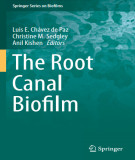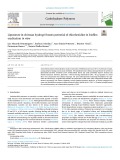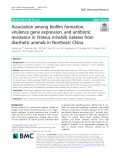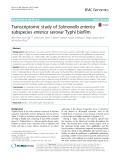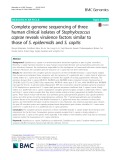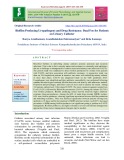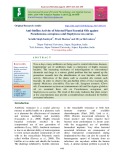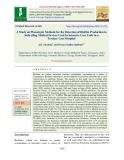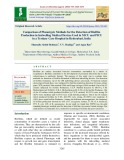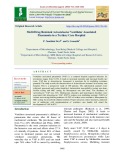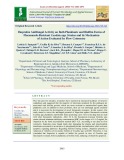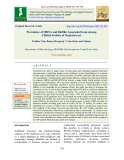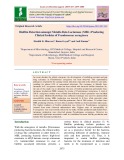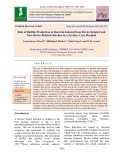
Biofilm associated infections
-
Ebook "The root canal biofilm (Volume 9)" presents the current state of research on the basic scientific aspects of root canal biofilm biology within a clinically applicable context. Root canal biofilms are complex polymicrobial structures adhering to the root canal surface that are formed by microorganisms invading the pulpal space of teeth, and are associated with persistent root canal infections.
 369p
369p  manmanthanhla0201
manmanthanhla0201
 26-02-2024
26-02-2024
 6
6
 1
1
 Download
Download
-
Ebook "Glycoscience and microbial adhesion (Topics in current chemistry, Volume 288)" explains all PIA-related principles of medical device-associated infections. It is our hope, that this collection of expert articles, ranging from structural ch- istry and structural biology to biochemistry and medicine, will be a stimulation and motivation for our colleagues in the life sciences.
 194p
194p  manmanthanhla0201
manmanthanhla0201
 26-02-2024
26-02-2024
 1
1
 1
1
 Download
Download
-
Successful treatment of skin infections requires eradication of biofilms found in up to 90 % of all chronic wounds, causing delayed healing and increased morbidity. We hypothesized that chitosan hydrogel boosts the activity of liposomally-associated membrane active antimicrobials (MAA) and could potentially improve bacterial and biofilm eradication.
 10p
10p  viginny
viginny
 30-12-2022
30-12-2022
 3
3
 2
2
 Download
Download
-
The aim of this study was to investigate the association among biofilm formation, virulence gene expression, and antibiotic resistance in P. mirabilis isolates collected from diarrhetic animals (n = 176) in northeast China between September 2014 and October 2016.
 10p
10p  vigandhi
vigandhi
 23-02-2022
23-02-2022
 14
14
 1
1
 Download
Download
-
Typhoid fever is an acute systemic infection of humans caused by Salmonella enterica subspecies enterica serovar Typhi (S. Typhi). In chronic carriers, the bacteria survive the harsh environment of the gallbladder by producing biofilm. The phenotype of S. Typhi biofilm cells is significantly different from the free-swimming planktonic cells, and studies have shown that they are associated with antibiotic resistance, immune system evasion, and bacterial persistence. However, the mechanism of this transition and the events leading to biofilm formation are unknown.
 9p
9p  vilarryellison
vilarryellison
 29-10-2021
29-10-2021
 11
11
 1
1
 Download
Download
-
Staphylococcus caprae is an animal-associated bacterium regarded as part of goats’ microflora. Recently, S. caprae has been reported to cause human nosocomial infections such as bacteremia and bone and joint infections. However, the mechanisms responsible for the development of nosocomial infections remain largely unknown. Moreover, the complete genome sequence of S. caprae has not been determined.
 17p
17p  vitzuyu2711
vitzuyu2711
 29-09-2021
29-09-2021
 9
9
 1
1
 Download
Download
-
Staphylococcus epidermidis is a common commensal of the skin and mucous membranes of humans. However, it is a common cause of nosocomial infection especially infection associated with the insertion of biomedical devices. Glycans have been shown to mediate vast majority of biological processes and its alterations have been reported to be used as biomarkers and applied in diagnosis of malignancies and infections. The absolute mean Optical Density (OD450nm) of the biofilm was calculated as 0.248± 0.044SD and the biofilm was observed to strongly adhere to the microtitre plate surface.
 10p
10p  caygaocaolon8
caygaocaolon8
 07-11-2020
07-11-2020
 9
9
 2
2
 Download
Download
-
Microbial biofilms in indwelling urinary catheters promote persistent and recurrent infections. This is due to their complex nature and resistance to commonly used antibiotics that are a challenge to management of catheter associated urinary tract infection (CAUTI). The present study was conducted to detect biofilm production by isolates from patients with CAUTI, and their association with antibiotic resistance.
 5p
5p  trinhthamhodang7
trinhthamhodang7
 31-08-2020
31-08-2020
 11
11
 2
2
 Download
Download
-
Now-a-days, many antibiotics are being used to control infectious diseases. Inappropriate use of antibiotics leads to emergence of highly resistant bacteria. The increasing resistance of microorganism to conventional chemicals and drugs is a serious global problem that has opened up the promotion research into the identification of new biocides with broad activity.
 7p
7p  chauchaungayxua6
chauchaungayxua6
 26-06-2020
26-06-2020
 15
15
 1
1
 Download
Download
-
Biofilms are surface associated bacterial communities surrounded by a matrix of exopolymers. Biofilms contribute to the development of persistent infections due to their refractiveness to antibiotic therapy. The purpose of this study was to evaluate three methods for detection of biofilm formation in different indwelling devices.
 13p
13p  angicungduoc5
angicungduoc5
 14-06-2020
14-06-2020
 14
14
 0
0
 Download
Download
-
Biofilms are surface associated bacterial communities surrounded by a matrix of exopolymers. Biofilms contribute to the development of persistent infections due to their refractiveness to antibiotic therapy. The purpose of this study was to evaluate three methods for detection of biofilm formation in different indwelling devices.
 9p
9p  kethamoi5
kethamoi5
 03-06-2020
03-06-2020
 24
24
 1
1
 Download
Download
-
Ventilator associated pneumonia (VAP) is a common hospital acquired infection. Its prevalence ranges from 9-24%. It leads to increased mortality and increased health care costs. VAP due to Acinetobacter baumannii is notorious for its multidrug resistance potential. The study reveals the characteristics of Acinetobacter baumanii in a tertiary care hospital. This is a prospective study of 100 patients. The endotracheal aspirates were collected, processed and isolate identified. Antimicrbial susceptibility testing was done, biofilm testing and MIC testing for Meropenem was also done.
 16p
16p  nguathienthan4
nguathienthan4
 18-04-2020
18-04-2020
 15
15
 1
1
 Download
Download
-
Over the past few decades, researches have reported an increased incidence of invasive candidiasis and suggested that the majority of infections produced by this pathogen are associated with biofilm growth, which are more resistant to antimicrobial agents than planktonic cells. In addition to these problems, there are few antifungal agents available and it is necessary the development of novel therapeutic strategies. In that context, this study aimed to assess the antifungal potential of ibuprofen against fluconazole-resistant Candida spp.
 11p
11p  trinhthamhodang1212
trinhthamhodang1212
 06-04-2020
06-04-2020
 12
12
 2
2
 Download
Download
-
Staphylococcus spp is a major cause of nosocomial and community-acquired infections and represents a significant burden on the healthcare system. Establishment of a mature biofilm, play an important role in the persistence of chronic infections and also decreases the susceptibility to antimicrobials and immune defenses, making these infections difficult to eradicate. MRSA and MR-CONS has become a major public health problem in both hospitals and communities. PVL has been reported to be an important marker for the highly pathogenic community acquired S. aureus infections.
 8p
8p  trinhthamhodang4
trinhthamhodang4
 22-03-2020
22-03-2020
 8
8
 1
1
 Download
Download
-
In recent decades the global emergence the development of multidrug-resistant and pan drug resistance in Pseudomonas aeruginosa has been observed. This opportunistic pathogen is responsible for causing various infections especially in the intensive care units, resulting for almost 10% of nosocomial infections. The resistance to Metallo betalactamase in P. aeruginosa strains has been related with bacterial biofilm formation. So, the aim of this study was to determine the rates of biofilm production and metallo betalactamase production (MBL) among the strains of Pseudomonas aeruginosa.
 6p
6p  trinhthamhodang3
trinhthamhodang3
 22-02-2020
22-02-2020
 8
8
 0
0
 Download
Download
-
The use of indwelling devices both temporary and permanent, in medical and surgical practice has led to the emergence of implant associated infections in the patients admitted in a Tertiary care hospital leading to partial or complete therapeutic failure. The study was conducted to detect and compare biofilm production in bacteria isolated from device related (DR) and non-device related (NDR) infections by Tissue Culture Method (TCP).
 9p
9p  nguaconbaynhay1
nguaconbaynhay1
 04-12-2019
04-12-2019
 17
17
 0
0
 Download
Download
-
More than 2,500 serotypes of Salmonella exist. However, only some of these serotypes have been frequently associated with food-borne illnesses. This book contains nineteen chapters which cover a range of different topics, such as the role of foods in Salmonella infections, food-borne outbreaks caused by Salmonella, biofilm formation, antimicrobial drug resistance of Salmonella isolates, methods for controlling Salmonella in food, and Salmonella isolation and identification methods.
 450p
450p  ktct_1669
ktct_1669
 09-05-2012
09-05-2012
 229
229
 37
37
 Download
Download
CHỦ ĐỀ BẠN MUỐN TÌM








